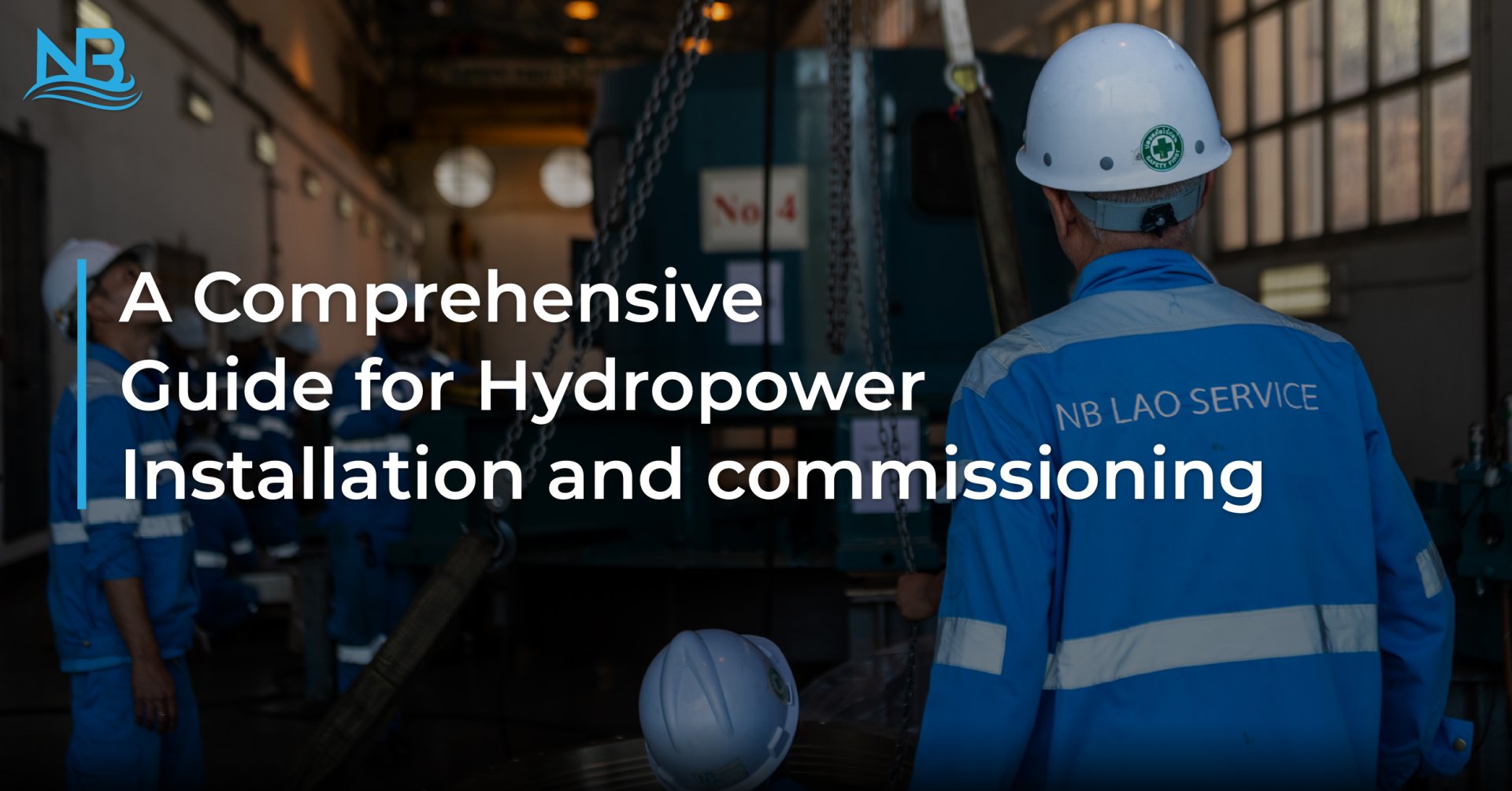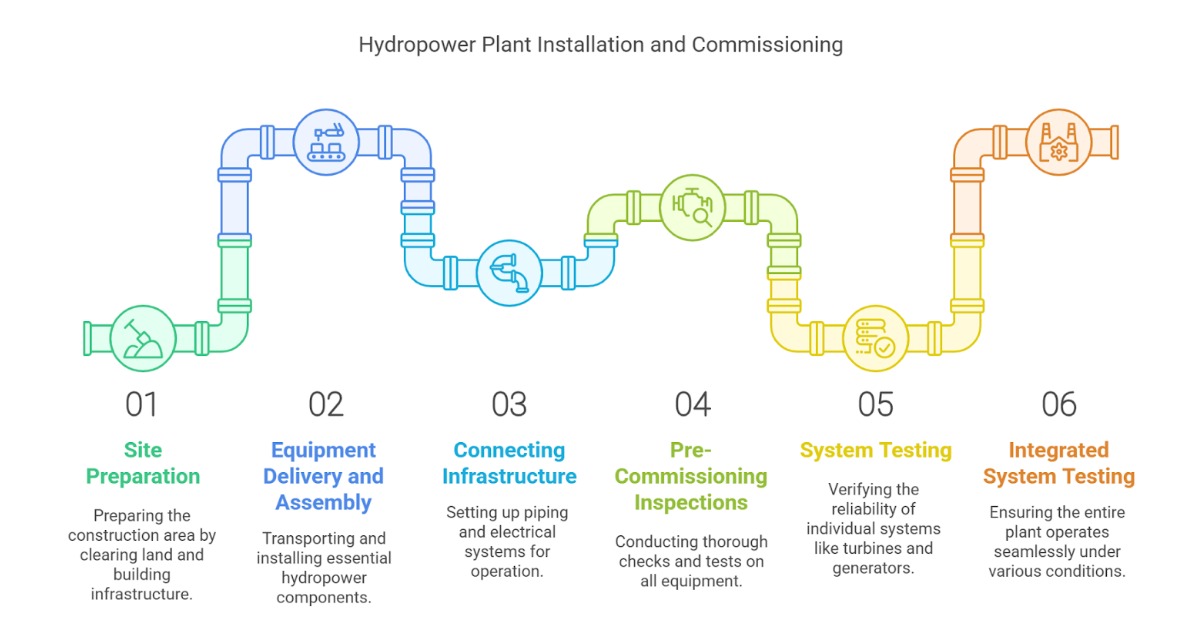A Comprehensive Guide to Hydropower Plant Installation and Commissioning

Hydropower is one of the most reliable and sustainable sources of renewable energy, harnessing the natural flow of water to generate electricity. However, before a hydropower plant can produce energy efficiently, it must go through an intricate installation and commissioning process. This blog explores the essential steps involved in transforming a blueprint into a fully operational power plant.
Site Preparation: Laying the Foundation for Success
Before construction begins, the site must be meticulously prepared to ensure stability and efficiency. This is a critical step that determines the long-term reliability and safety of the plant.
- Land Clearing - Removing vegetation, rocks, and other obstructions to prepare the construction area.
- Excavation - Digging out spaces for the foundation, dam, powerhouse, and essential structures.
- Infrastructure Construction - Building key components such as the dam, penstock (water conduit to turbines), powerhouse, and access roads.
This phase often involves extensive earthmoving and civil engineering work, requiring precise planning to prevent erosion, landslides, or structural weaknesses that could impact the plants future operations.
Equipment Delivery and Assembly
Once the groundwork is complete, the next step involves transporting and installing essential equipment. This is where hydropower truly takes shape.
- Transportation - Moving large-scale components, including turbines, generators, transformers, and control systems, to the site. Given the size and weight of these components, logistics planning is crucial to ensure safe and timely delivery.
- Precision Installation - Assembling and positioning each component accurately according to engineering specifications. Proper alignment and secure installation are key to minimizing operational risks.
Depending on the project's scale, this phase can take weeks or even months, with heavy machinery playing a vital role in lifting and positioning massive parts.
Connecting the Infrastructure
Ensuring a smooth flow of water and electricity is critical for the plant's operation. These elements form the circulatory and nervous systems of a hydropower plant.
- Piping Installation - Constructing a network of pipes to efficiently direct water to turbines. This includes installing penstocks, which must be designed to withstand immense water pressure.
- Electrical Cabling - Setting up connections between generators, transformers, and control systems to facilitate power distribution. High-voltage cabling must be carefully insulated and routed to prevent faults.
At this stage, engineers meticulously verify all connections to avoid leaks, inefficiencies, or potential safety hazards.
Pre-Commissioning Inspections
Before the plant is activated, each component undergoes thorough evaluation to prevent operational failures. This step is crucial for identifying and addressing potential issues before full-scale operation.
- Equipment Inspection - Checking all installed components for damage, defects, or misalignment.
- Functionality Tests - Ensuring each part operates as expected before full-scale testing begins.
This process includes everything from bolt-tightening to software checks on automated control systems, ensuring every aspect is functioning properly before moving to the next phase.
System Testing
Each system must pass rigorous testing to confirm operational reliability.
- Turbine Rotation Check - Ensuring smooth and unhindered rotation under various water flow conditions.
- Generator Testing - Verifying that the generator produces electricity effectively and can handle fluctuations in power demand.
- Control System Calibration - Checking automation and response accuracy to ensure operators can monitor and adjust settings as needed.
Testing is conducted under controlled conditions, gradually increasing complexity to mimic real-world operation.
Integrated System Testing
Once individual systems are verified, the entire plant is tested under operational conditions to ensure everything works together seamlessly.
- Load Variation Simulation - Assessing the plants ability to handle different energy demands.
- Grid Synchronization - Ensuring smooth integration with the national power grid without frequency or voltage disruptions.
- Emergency Shutdown Simulation - Testing safety measures for rapid shutdown in case of emergencies, including grid failures or equipment malfunctions.
A successful integrated test confirms that the plant is ready for commercial operation.
Performance Optimization
Optimizing settings and calibrations ensures long-term operational efficiency and maximizes energy output.
- Turbine and Control Adjustments - Fine-tuning settings for optimal power output and energy efficiency.
- System Performance Analysis - Identifying and resolving any inefficiencies through real-time monitoring and data analysis.
Continuous improvements are made based on initial performance results, ensuring maximum energy generation with minimal waste.
Environmental Monitoring
Hydropower plants must operate responsibly to minimize environmental impact and maintain sustainability.
- Water Quality Management - Regular testing to ensure compliance with environmental regulations.
- Wildlife Protection - Implementing measures to protect aquatic life and maintain ecological balance, such as fish ladders or bypass channels.
This step is vital for ensuring that the benefits of hydropower do not come at the expense of local ecosystems.
Installation and Commissioning of Essential Hydropower Equipment
Proper installation and commissioning ensure the long-term efficiency and reliability of hydropower plants. Key components include:
- Electrical Systems - Power transmission and distribution systems, including protection and control equipment.
- Mechanical Systems - Assembly and installation of mechanical components such as water pipes, pumps, and cooling systems.
- Generator - Installation and adjustment of generators for optimal performance.
- Turbine - Turbine assembly, balance checks, and performance testing.
- Transformer - Installation and testing of transformers to connect the electrical system to the grid.
- Control Systems (PLC and SCADA) - Configuration of programs and hardware, including signal connection checks between devices.
- Governor System - Installation and adjustment of speed control systems for turbines.
- Excitation System - Installation of voltage regulation systems for generators.
- Substation - Installation of high-voltage equipment such as transformers, breakers, and transmission systems.
Key Factors for a Successful Hydropower Plant Installation
To ensure a smooth installation and commissioning process, these best practices are crucial:
- Adherence to Project Design - Following detailed blueprints and engineering plans meticulously.
- Strict Safety Protocols - Prioritizing worker safety and emergency preparedness.
- Regulatory Compliance - Meeting all industry and environmental standards.
- Quality Control Measures - Conducting thorough inspections and tests at every stage.
- Skilled Workforce - Employing experienced engineers and technicians to ensure precision and efficiency.
The installation and commissioning of a hydropower plant is a highly technical and meticulous process that lays the foundation for long-term energy production. By following structured procedures and focusing on safety, efficiency, and environmental sustainability, hydropower can continue to serve as a cornerstone of the renewable energy transition.
With extensive experience in hydropower installation and commissioning, NB Lao provides expert services to ensure smooth project execution. Our team of skilled engineers and technicians ensures that every step, from site preparation to final performance optimization, is handled with precision and care. Whether it's electrical systems, turbine installation, or control system integration, NB Lao is committed to delivering high-quality solutions for the future of hydropower.



